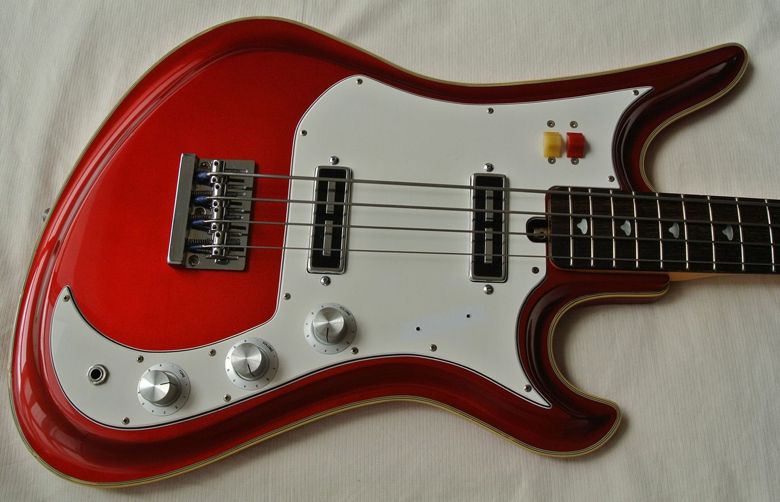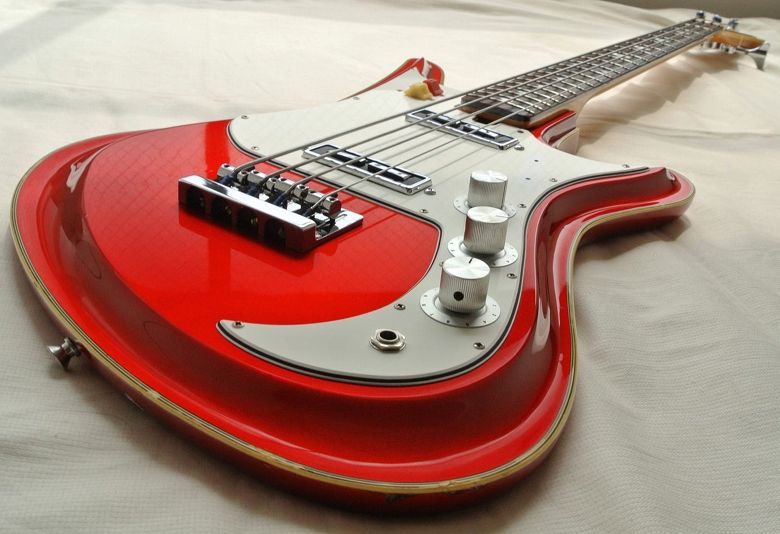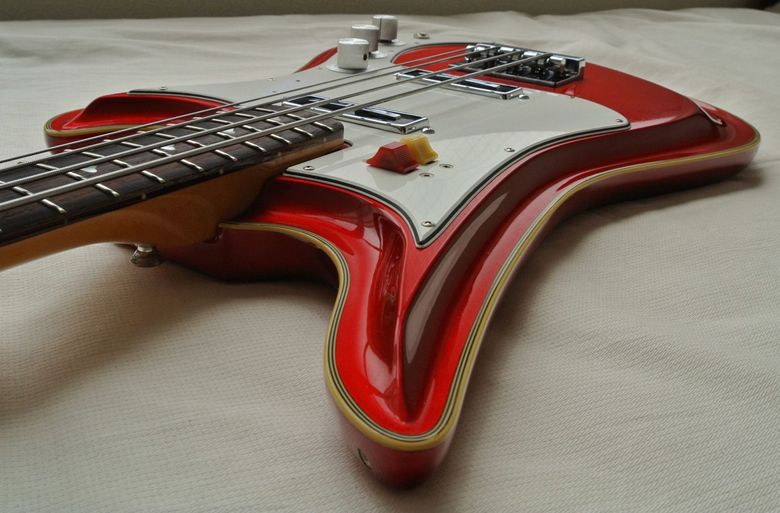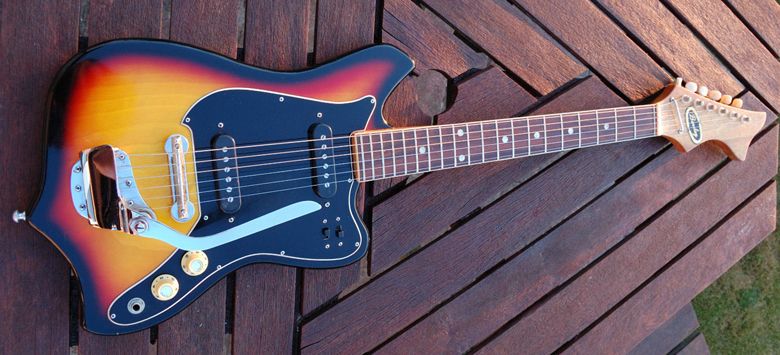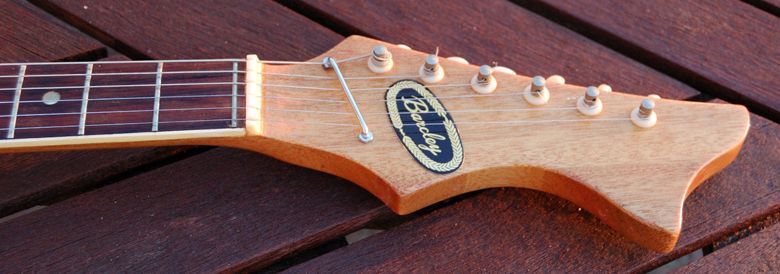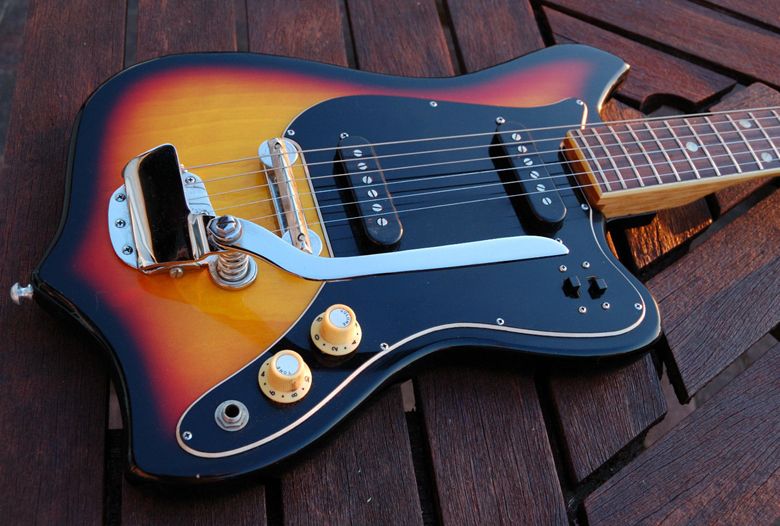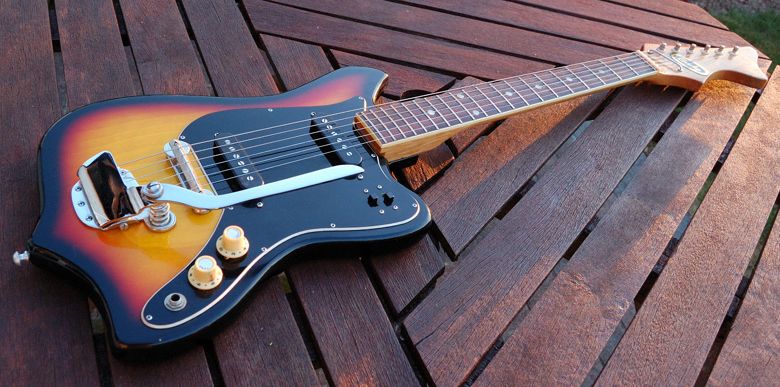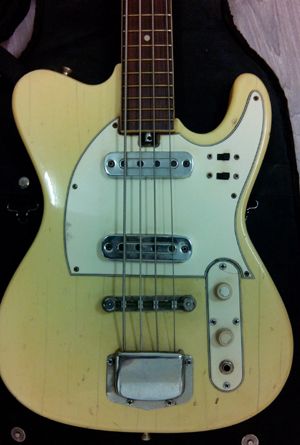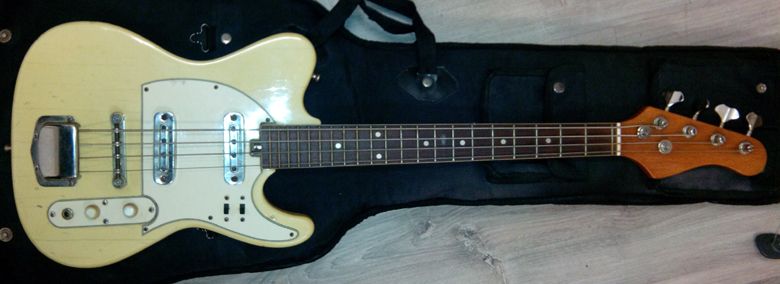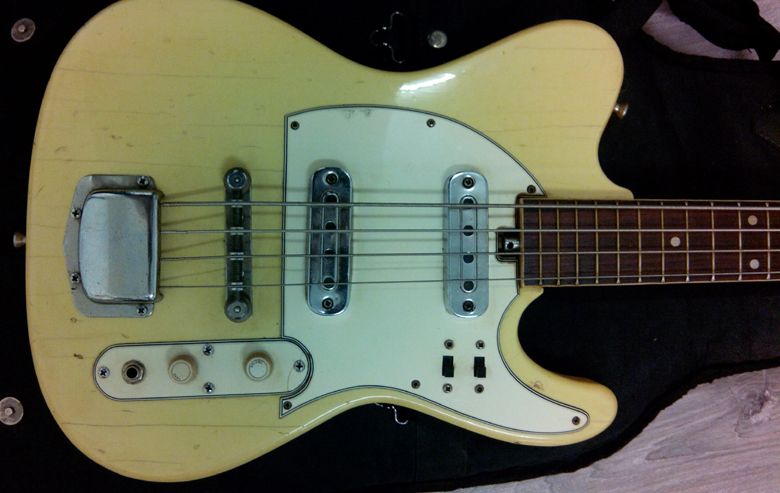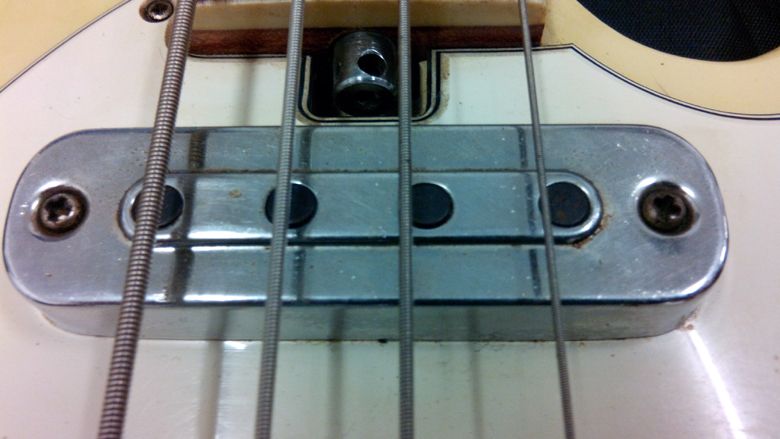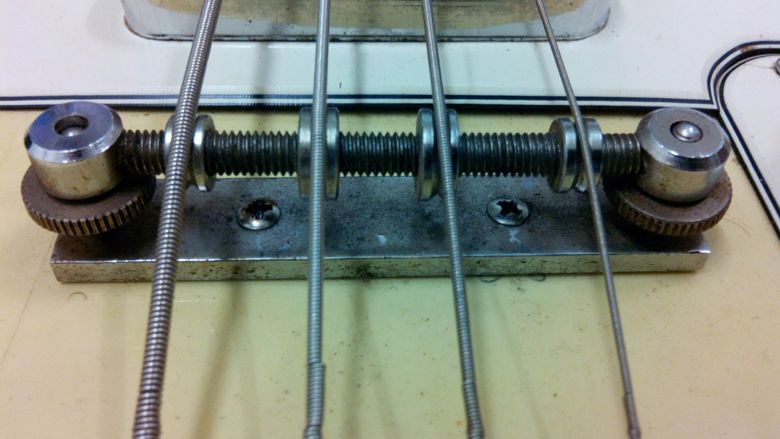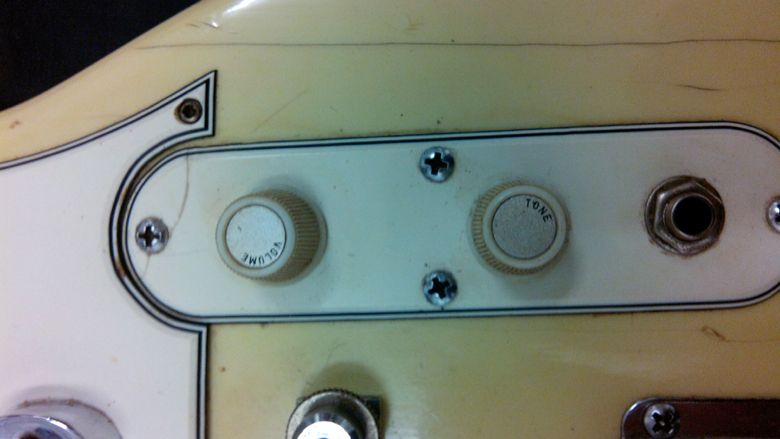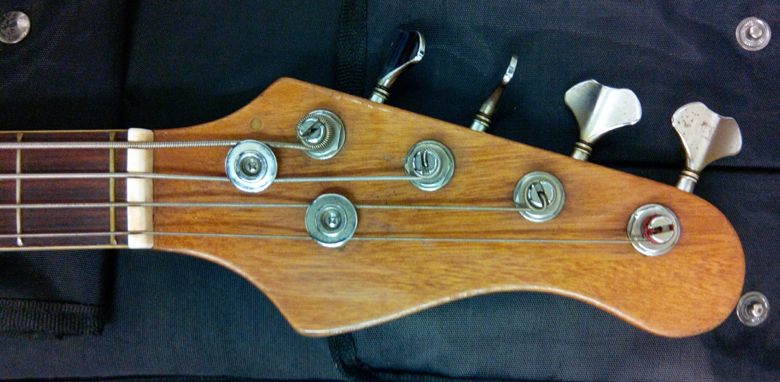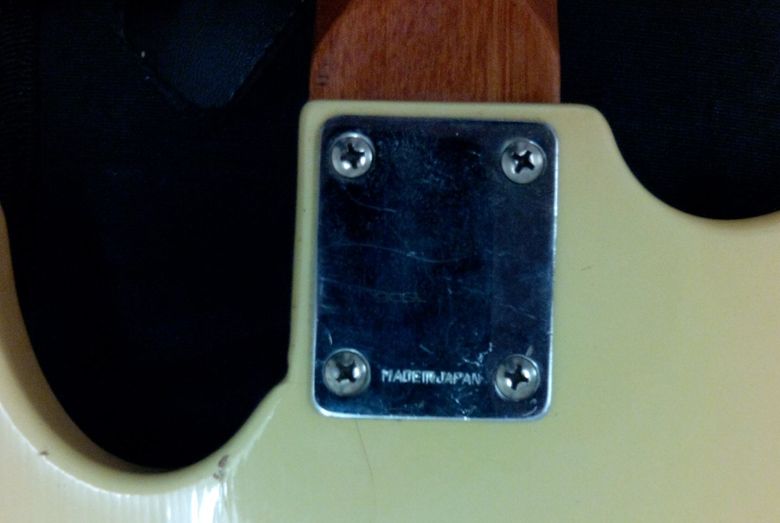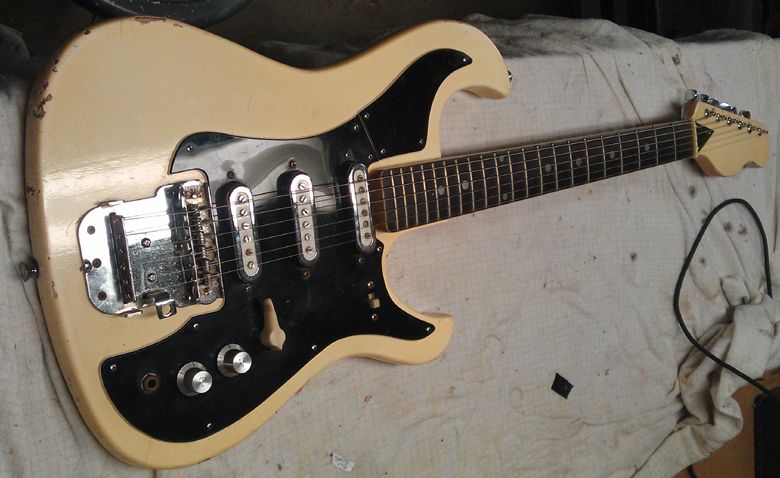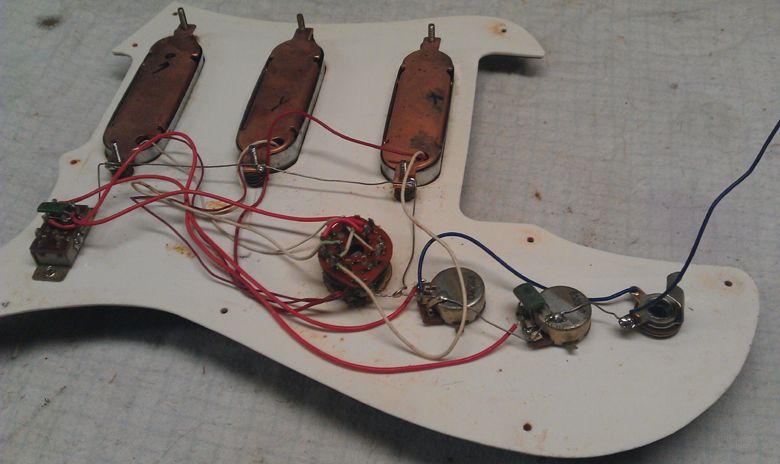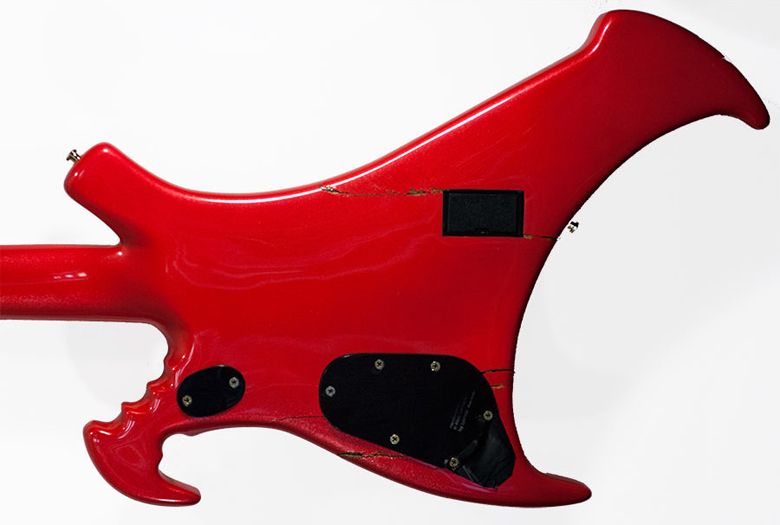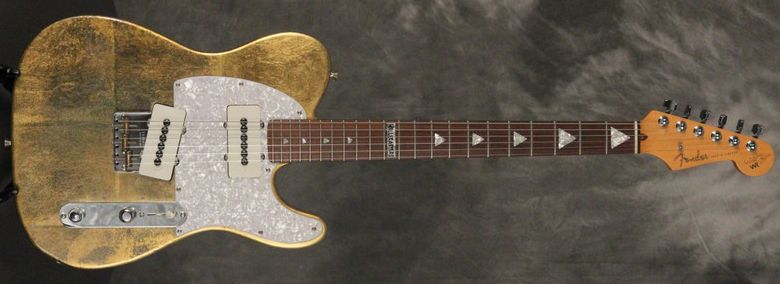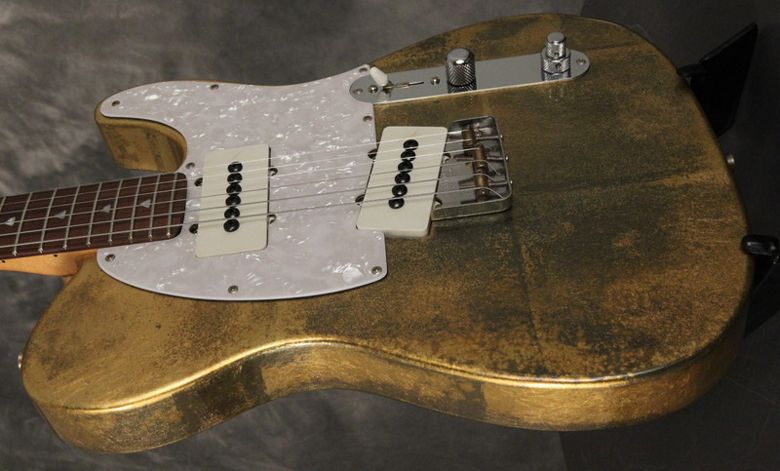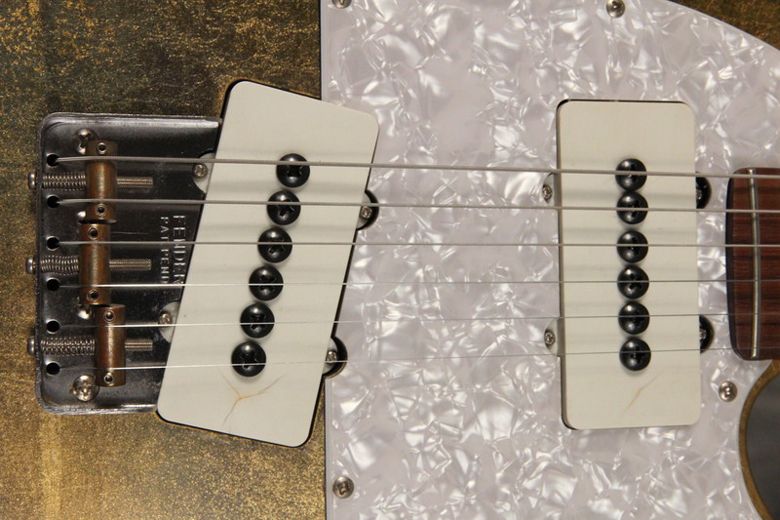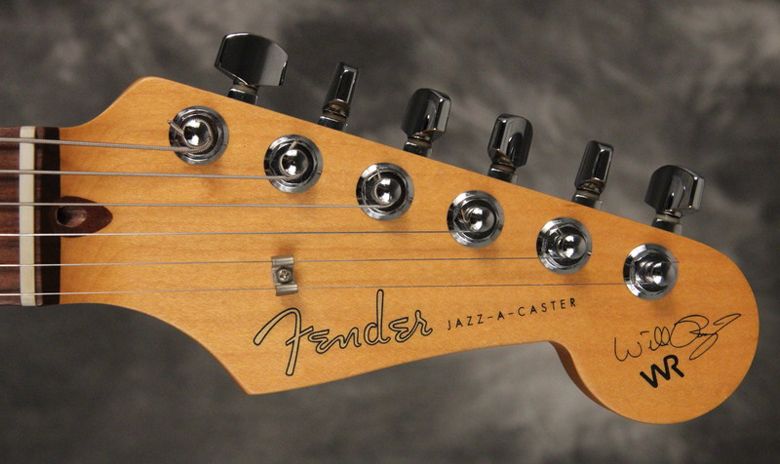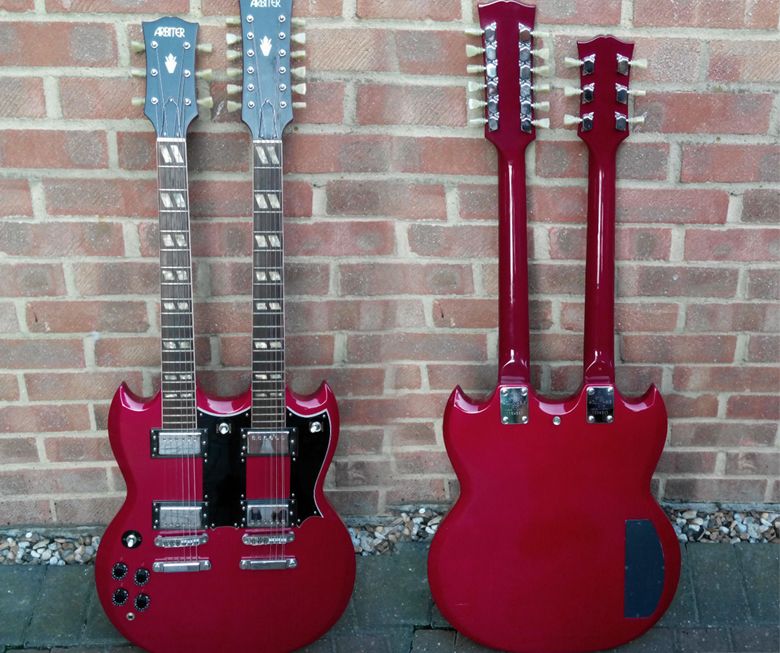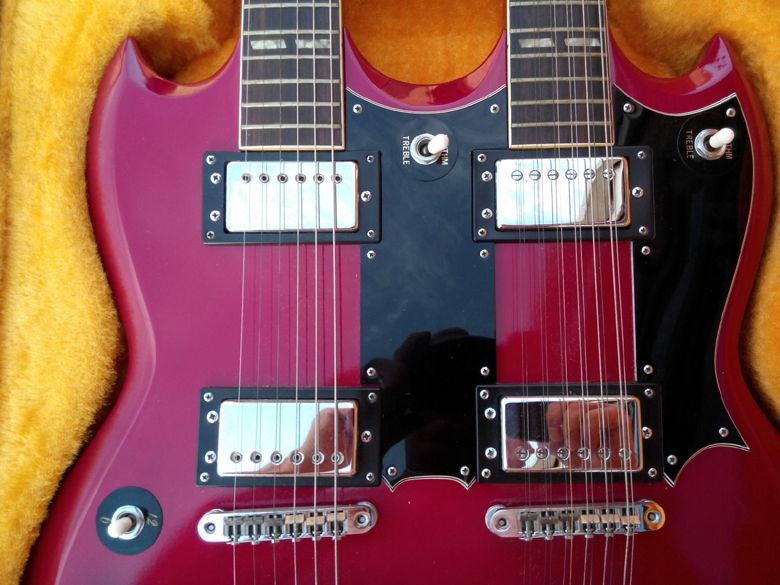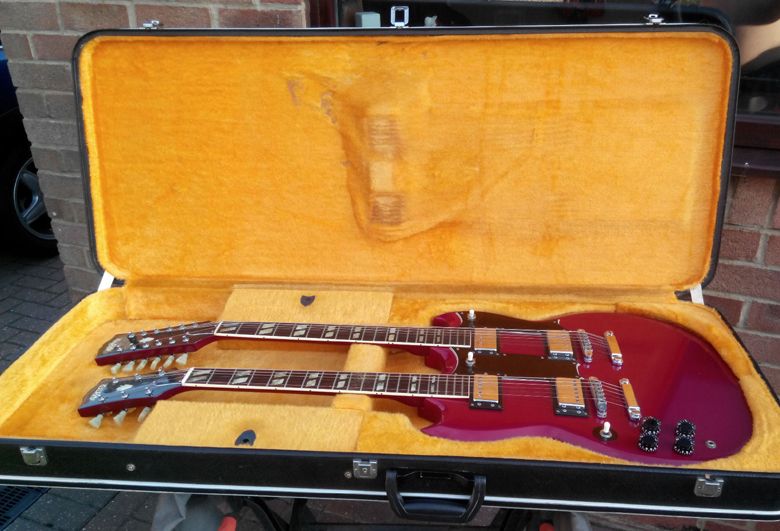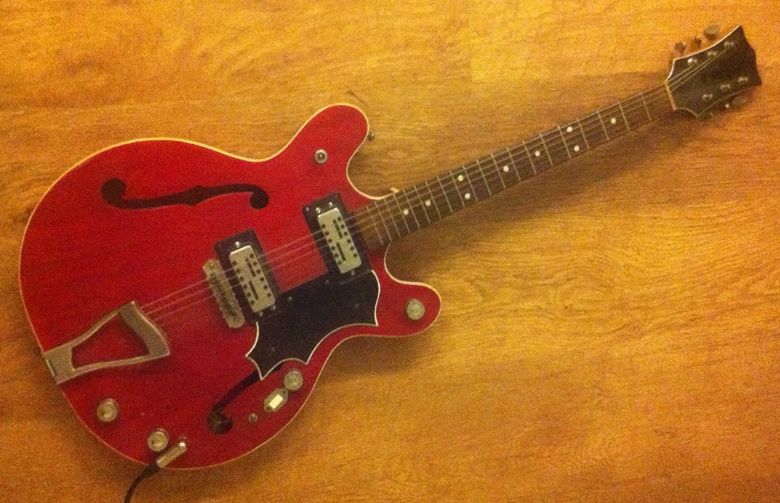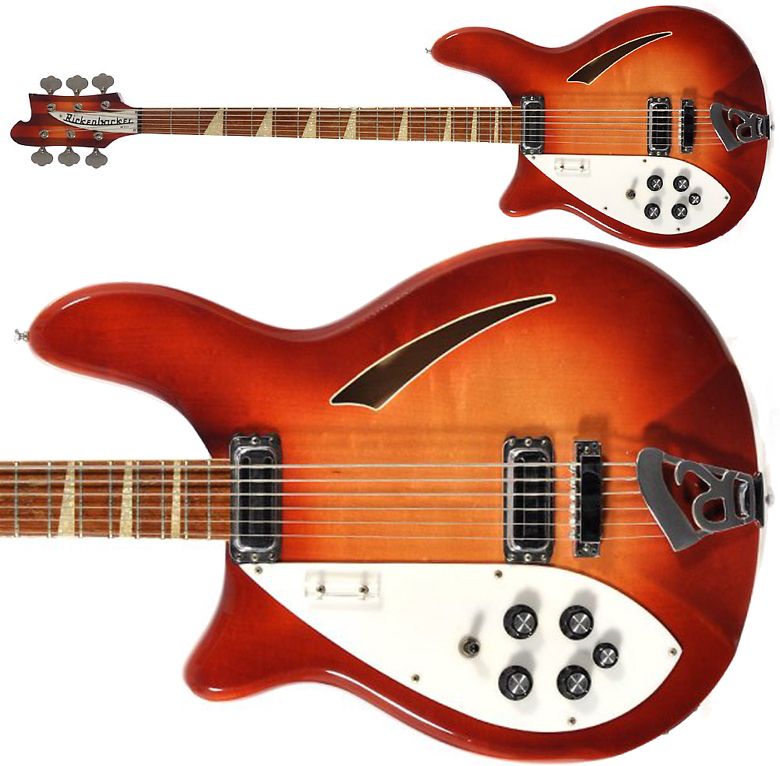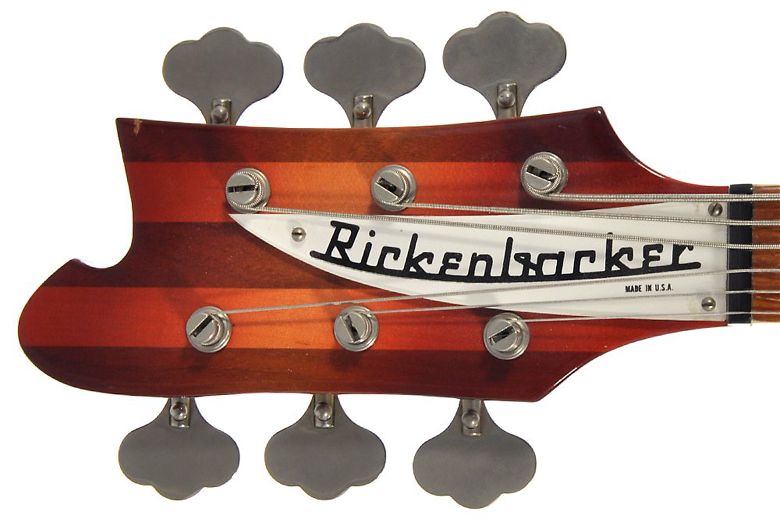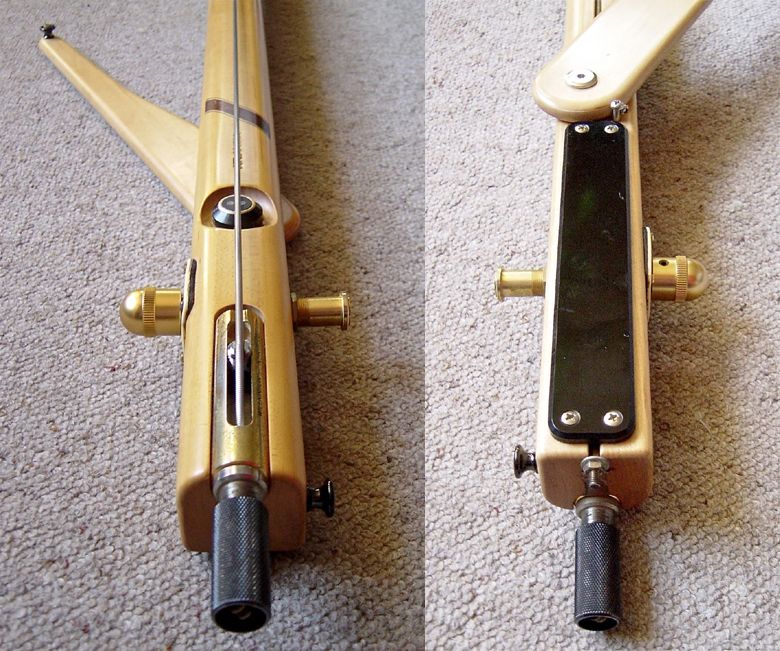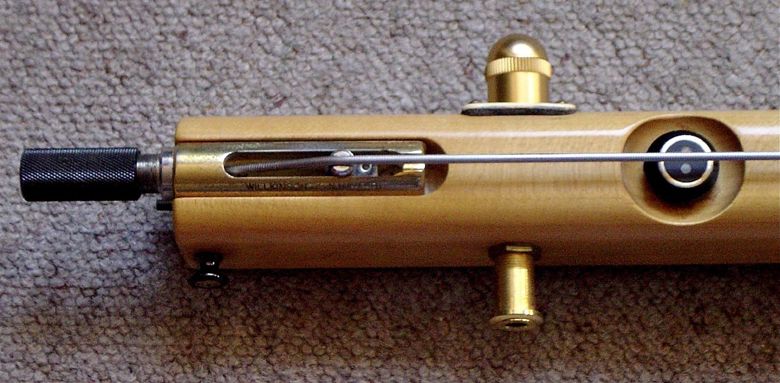guitarz.blogspot.com:
We've looked at similar design Teisco Spectrum 5 guitars here before (here, here and here) but until I saw this eBay listing just now I hadn't realised that there was a bass version too, the Teisco
SPB-200 Spectrum Bass. What an absolute beauty, just check out those curves and contours and that gorgeous German carve! It's a short-scale bass with a scale length of 30.3", so it's going to have a certain retro tone but that's not something that should put off any bassist with imagination.
Like Henry Kaiser's see-thru acrylic-bodied Spectrum 5, it isn't a vintage Teisco but rather a relatively modern Japanese-made "re-issue", circa 2000 (see more here). (Obviously, the originals were Japanese-made too, I just wanted to emphasise that it wasn't made in Korea, China, Indonesia, etc, as many other re-issues are these days).
Currently listed on eBay with a Buy It Now price of US $699.99 (item located in Japan).
G L Wilson
© 2014, Guitarz - The Original Guitar Blog - the blog that goes all the way to 11!
Please read our photo and content policy.
Sunday, 28 September 2014
Thursday, 25 September 2014
Barcley-branded Japanese copy of Fender Maverick/Custom
guitarz.blogspot.com:
The Fender Custom - also known as the Maverick (see here) - was a short-lived model "designed" by the CBS-owned incarnation of the Fender Corporation and was really an exercise in using up stock body and neck components for the Fender Electric XII (first produced in 1965) which had not proved to be a big seller. The resulting guitars do appear to our eyes now to be Frankenstein jobs, but perhaps we should applaud Fender who were essentially simply re-cycling (or is that up-cycling) parts. According to Fender, just "several hundred" were made and the model was never popular; it was only produced for one year and managed to hang on in the Fender catalogue until 1972.
...which makes it all the more bizarre that someone in Japan thought it would be a good guitar to make a copy of. Witness the photos above of this Japanese-made Barcley guitar currently listed on eBay UK. The hardware is pretty standard fodder for cheap Japanese guitars of the time, and the neck makes no attempt to copy the 12-string derived hockeystick headstock of the Fender "original". In fact, here the headstock is a design that some of us might recognise from other Japanese brands such as Greco and Sekova.
The body design, however, is pure Custom/Maverick. It seems strange to think that this body was cut out and shaped deliberately to look like the body of a guitar that took a Fender Electric XII body and cut chunks off of it!
This guitar is currently listed on eBay UK and has a Buy It Now price of £129. Thanks to occasional Guitarz contributor David from Barcelona for bringing this guitar to my attention via the Vintage Japanese Guitar Fanclub group page on Facebook. Incidentally, the discussion on the thread concerning this guitar mentions that the Barcley brandname (spelt with a "E") was for guitars intended for the Canadian market, whereas Barclay (with an "A") was for the USA.
You can read more about the original Fender Custom/Maverick and also the similar "up-cycled" Swinger/Musiclander/Arrow model here.
G L Wilson
© 2014, Guitarz - The Original Guitar Blog - the blog that goes all the way to 11!
Please read our photo and content policy.
The Fender Custom - also known as the Maverick (see here) - was a short-lived model "designed" by the CBS-owned incarnation of the Fender Corporation and was really an exercise in using up stock body and neck components for the Fender Electric XII (first produced in 1965) which had not proved to be a big seller. The resulting guitars do appear to our eyes now to be Frankenstein jobs, but perhaps we should applaud Fender who were essentially simply re-cycling (or is that up-cycling) parts. According to Fender, just "several hundred" were made and the model was never popular; it was only produced for one year and managed to hang on in the Fender catalogue until 1972.
...which makes it all the more bizarre that someone in Japan thought it would be a good guitar to make a copy of. Witness the photos above of this Japanese-made Barcley guitar currently listed on eBay UK. The hardware is pretty standard fodder for cheap Japanese guitars of the time, and the neck makes no attempt to copy the 12-string derived hockeystick headstock of the Fender "original". In fact, here the headstock is a design that some of us might recognise from other Japanese brands such as Greco and Sekova.
The body design, however, is pure Custom/Maverick. It seems strange to think that this body was cut out and shaped deliberately to look like the body of a guitar that took a Fender Electric XII body and cut chunks off of it!
This guitar is currently listed on eBay UK and has a Buy It Now price of £129. Thanks to occasional Guitarz contributor David from Barcelona for bringing this guitar to my attention via the Vintage Japanese Guitar Fanclub group page on Facebook. Incidentally, the discussion on the thread concerning this guitar mentions that the Barcley brandname (spelt with a "E") was for guitars intended for the Canadian market, whereas Barclay (with an "A") was for the USA.
You can read more about the original Fender Custom/Maverick and also the similar "up-cycled" Swinger/Musiclander/Arrow model here.
G L Wilson
© 2014, Guitarz - The Original Guitar Blog - the blog that goes all the way to 11!
Please read our photo and content policy.
Wednesday, 24 September 2014
What is this vintage Japanese (very) short-scale bass?
guitarz.blogspot.com:
Dirk writes:
Hi Dirk, it looks to me like a Jedson. The design is very loosely based on that of the Telecaster. I'm pretty sure these guitars and (very) short-scale basses also appeared with other brand names on the headstock, e.g. Zenta.
There is a similar Jedson bass in sunburst on eBay UK at the time of writing, and it is priced at £165 which seems to be the going rate for these today. Personally, I'd value it at nearer £50, but perhaps some Jedson/Zenta fans out there might like to explain why they are worth more.
The only (minor) claim to fame that these guitars have, as far as I am aware, is that Nigel Planer's character Neil was playing one of these (the six string guitar version) in the stolen Routemaster bus before it went over the cliff in the final episode of the classic BBC TV comedy The Young Ones.
G L Wilson
© 2014, Guitarz - The Original Guitar Blog - the blog that goes all the way to 11!
Please read our photo and content policy.
Dirk writes:
Hi Gavin...
I'd need your help please to identify this plywood bass, short-scale...
Seems to be late sixties, early seventies, Japanese made...Tuners changed, rest original...Fully operating, no buzz, not quite playable got to fiddle out a set of strings.....So if you or any of your readers could hint me, I'd appreciate highly....Cheers, thanx and keep your Independence...Dirk
Hi Dirk, it looks to me like a Jedson. The design is very loosely based on that of the Telecaster. I'm pretty sure these guitars and (very) short-scale basses also appeared with other brand names on the headstock, e.g. Zenta.
There is a similar Jedson bass in sunburst on eBay UK at the time of writing, and it is priced at £165 which seems to be the going rate for these today. Personally, I'd value it at nearer £50, but perhaps some Jedson/Zenta fans out there might like to explain why they are worth more.
The only (minor) claim to fame that these guitars have, as far as I am aware, is that Nigel Planer's character Neil was playing one of these (the six string guitar version) in the stolen Routemaster bus before it went over the cliff in the final episode of the classic BBC TV comedy The Young Ones.
G L Wilson
© 2014, Guitarz - The Original Guitar Blog - the blog that goes all the way to 11!
Please read our photo and content policy.
Monday, 22 September 2014
No-name 1960s Japanese solidbody guitar with a strong Burns influence
guitarz.blogspot.com:
Tyler B writes:
I thought I'd share with you the most recent addition to my collection. Outside of the fact that it is made in Japan, and likely mid-to-late 60s, I can't really tell you more about it's origin. The seller was quick to throw around the word Teisco and while that may very well be accurate, I'm not going to assert it as fact. I've seen the same truss rod cover and pickups on Imperial and Guyatone branded guitars specifically, but coming from a time when building guitars was anyone's game, who knows. There is no trace of any emblem or other branding anywhere; no glue residue, screw holes, etc.
However, I do know it has a definite resemblance to the Burns Bison. The pointed horns, large single coils, and a segmented pickguard really pick it out as an obvious influence.
The rotary allows you to select the usual 5 positions on a Strat, and offers a sixth position for all 3 pickups at once. I can't really tell what the slider switch does for sure, though it seems to be wired to the tone circuit (you may be able to see in the picture), perhaps some sort of boost?
Beyond the electronics, the hardware is the usual kind you'd expect on a guitar like this. Sadly, while the bridge is still easily adjustable, the roller saddles have succumbed to decades of neglect and are frozen. That said, without the bar, the vibrato won't do much good anyhow...but it sure is pretty! I also found the neck pocket pretty interesting.
This was a rare one for me, I never seem to get these old things in working order, it was nice to be able to clean it up and go without having to completely restore it! Plays pretty well thanks in part to a straight neck and fairly clean frets, I'm hoping to get it out on stage sometime soon!
Tyler B
© 2014, Guitarz - The Original Guitar Blog - the blog that goes all the way to 11!
Please read our photo and content policy.
Tyler B writes:
I thought I'd share with you the most recent addition to my collection. Outside of the fact that it is made in Japan, and likely mid-to-late 60s, I can't really tell you more about it's origin. The seller was quick to throw around the word Teisco and while that may very well be accurate, I'm not going to assert it as fact. I've seen the same truss rod cover and pickups on Imperial and Guyatone branded guitars specifically, but coming from a time when building guitars was anyone's game, who knows. There is no trace of any emblem or other branding anywhere; no glue residue, screw holes, etc.
However, I do know it has a definite resemblance to the Burns Bison. The pointed horns, large single coils, and a segmented pickguard really pick it out as an obvious influence.
The rotary allows you to select the usual 5 positions on a Strat, and offers a sixth position for all 3 pickups at once. I can't really tell what the slider switch does for sure, though it seems to be wired to the tone circuit (you may be able to see in the picture), perhaps some sort of boost?
Beyond the electronics, the hardware is the usual kind you'd expect on a guitar like this. Sadly, while the bridge is still easily adjustable, the roller saddles have succumbed to decades of neglect and are frozen. That said, without the bar, the vibrato won't do much good anyhow...but it sure is pretty! I also found the neck pocket pretty interesting.
This was a rare one for me, I never seem to get these old things in working order, it was nice to be able to clean it up and go without having to completely restore it! Plays pretty well thanks in part to a straight neck and fairly clean frets, I'm hoping to get it out on stage sometime soon!
Tyler B
© 2014, Guitarz - The Original Guitar Blog - the blog that goes all the way to 11!
Please read our photo and content policy.
Friday, 19 September 2014
1980s Westone Rail Bass headless design with sliding pickup
guitarz.blogspot.com:
Jorma Kim
Finland
Very nice. Thanks for the photos! - GLW
© 2014, Guitarz - The Original Guitar Blog - the blog that goes all the way to 11!
Please read our photo and content policy.
I'm
a casual bass player with a lifetime goal to eventually become a bit
better than at the moment. I first heard about Westone's Rail Bass in
your blog (http://guitarz.blogspot.fi/2009/04/westone-rail-bass.html),
and now a couple of years later I finally bought one on eBay. Cost me a
bit less than 500 euros (£380, $650). Even though red is the least cool
color it was produced in, I love the way it looks. Attached are a
couple of photos of the bass and its sliding pickup. You can use them in
the blog or store them in the archives.
Cheers,Jorma Kim
Finland
Very nice. Thanks for the photos! - GLW
© 2014, Guitarz - The Original Guitar Blog - the blog that goes all the way to 11!
Please read our photo and content policy.
Wednesday, 17 September 2014
Warwick Buzzard bass from John Entwistle's personal collection for sale on eBay
guitarz.blogspot.com:
One of the late Who bassist's personal instruments has come up for sale on ebay. The following extract is from the eBay listing by the seller 8thstreetmusic:
G L Wilson
© 2014, Guitarz - The Original Guitar Blog - the blog that goes all the way to 11!
Please read our photo and content policy.
One of the late Who bassist's personal instruments has come up for sale on ebay. The following extract is from the eBay listing by the seller 8thstreetmusic:
A piece of Rock n' Roll history - from John Entwistle's personal collection the Warwick "Pink Buzzard" in a red metallic finish (circa 1985). Gorgeous Bass guitar with signed custom hardshell case and an Entwistle spider doodle. The bass plays and looks great, the Illuminated side dots added a little extra flare and visibility while on stage.Currently listed on eBay with a Buy It Now price of US $32,500.
This bass has a huge crack down the middle and back. As the lore goes, while on tour in the mid 90's, Roger Daltry asked Entwistle to turn his bass down. In true rock and roll fashion, Entwistle threw the bass at Daltry and said, "you play the F***in' thing", as the bass hit the ground it cracked right down the middle.
G L Wilson
© 2014, Guitarz - The Original Guitar Blog - the blog that goes all the way to 11!
Please read our photo and content policy.
Monday, 15 September 2014
Silvertone 14409 vintage Japanese Mosrite-inspired surftastic guitar
guitarz.blogspot.com:
This 1960s Japanese "Silvertone model 14409" guitar (made by Kawai possibly?) has some very strong Mosrite stylistic influences, although that proto-Ibanez-style headstock does look a little at odds with the body design. Despite the obvious influences instruments like this are becoming increasingly sought after in their own right, with more and more collectors becoming interested in vintage Japanese-made guitars.
Currently listed on eBay with a Buy It Now price of $344.99.
G L Wilson
© 2014, Guitarz - The Original Guitar Blog - the blog that goes all the way to 11!
Please read our photo and content policy.
This 1960s Japanese "Silvertone model 14409" guitar (made by Kawai possibly?) has some very strong Mosrite stylistic influences, although that proto-Ibanez-style headstock does look a little at odds with the body design. Despite the obvious influences instruments like this are becoming increasingly sought after in their own right, with more and more collectors becoming interested in vintage Japanese-made guitars.
Currently listed on eBay with a Buy It Now price of $344.99.
G L Wilson
© 2014, Guitarz - The Original Guitar Blog - the blog that goes all the way to 11!
Please read our photo and content policy.
Friday, 12 September 2014
Fender Jazz-A-Caster, MIJ signature model of Will Ray of the Hellacasters
guitarz.blogspot.com:
This 1998 Japanese-made Will Ray (of the Hellacasters) signature model Fender Jazz-A-Caster is one of those weird Fender hybrids that takes one of their models and mixes it up with elements from another model. It's a bit like the Pawn Shop series but on a grander Custom Shop scale. This so-called Jazz-a-caster obviously has a lot of Telecaster in its DNA but also has a little Jazzmaster thrown into the mix. This particular model is signed by Will Ray and is numbered #242 out of 300 examples made.
Currently listed on eBay with a Buy It Now price of US $1,390. It's kind of ironic that he has this expensive signature model made by Fender when he writes Bottom Feeder, a regular column for Premier Guitar where he celebrates all his latest cheap and cheerful guitar acquisitions (and which I utterly applaud).
G L Wilson
© 2014, Guitarz - The Original Guitar Blog - the blog that goes all the way to 11!
Please read our photo and content policy.
This 1998 Japanese-made Will Ray (of the Hellacasters) signature model Fender Jazz-A-Caster is one of those weird Fender hybrids that takes one of their models and mixes it up with elements from another model. It's a bit like the Pawn Shop series but on a grander Custom Shop scale. This so-called Jazz-a-caster obviously has a lot of Telecaster in its DNA but also has a little Jazzmaster thrown into the mix. This particular model is signed by Will Ray and is numbered #242 out of 300 examples made.
Currently listed on eBay with a Buy It Now price of US $1,390. It's kind of ironic that he has this expensive signature model made by Fender when he writes Bottom Feeder, a regular column for Premier Guitar where he celebrates all his latest cheap and cheerful guitar acquisitions (and which I utterly applaud).
G L Wilson
© 2014, Guitarz - The Original Guitar Blog - the blog that goes all the way to 11!
Please read our photo and content policy.
Tuesday, 9 September 2014
a message from one of our readers (warning, graphic picture)
I received this message from Micha:
"Dear Bertram,
while looking through the internet, I found your blog post from 2010, about the ARIA Pro II Integra IG-CST.
I bought the ARIA Pro II Integra IG-CST 1993 when my daughter was born and played this special electric guitar for many years. Though listening and playing grows from my experience with my main instrument the bass clarinet, I was lucky that this electric guitar sounds great in any context…
In September 2012 a fire burned 8 of my guitars and amps and tools.
Since then I continued playing and upgraded my amps and guitars.
BUT the ARIA Pro II Integra IG-CST is a rare instrument...
I am looking for one that I can buy.
Please tell me if you know somebody who wants to sell his ARIA Pro II Integra IG-CST.
Best regards,
Micha"
Hope someone can help Micha with what seems indeed to be a great guitar!
Bertram D
© 2014, Guitarz - The Original Guitar Blog - the blog that goes all the way to 11!
Please read our photo and content policy.
Monday, 8 September 2014
Arbiter 12+6 Doubleneck leftie conversion
guitarz.blogspot.com:
As I already mentioned recently, I'm on something of a doubleneck kick lately. I'll explain more in a forthcoming blog post, but in the meantime here's a doublenck Arbiter 12+6 based on the now legendary Gibson EDS-1275, which has been very comptently converted into a left-handed guitar. It's got to be a better leftie doubleneck than some of the Chinese-made cheapies being sold on eBay.
Currently listed on eBay with a starting bid of £299.
G L Wilson
© 2014, Guitarz - The Original Guitar Blog - the blog that goes all the way to 11!
Please read our photo and content policy.
As I already mentioned recently, I'm on something of a doubleneck kick lately. I'll explain more in a forthcoming blog post, but in the meantime here's a doublenck Arbiter 12+6 based on the now legendary Gibson EDS-1275, which has been very comptently converted into a left-handed guitar. It's got to be a better leftie doubleneck than some of the Chinese-made cheapies being sold on eBay.
Currently listed on eBay with a starting bid of £299.
G L Wilson
© 2014, Guitarz - The Original Guitar Blog - the blog that goes all the way to 11!
Please read our photo and content policy.
Friday, 5 September 2014
Can anyone help identify this mystery semi-hollowbody guitar?
guitarz.blogspot.com:
G L Wilson
EDIT (8 Sept 2014): Arjen Matthys Ehlers tells us via Facebook that "It's a German GIMA, occasionally they pop up in the Netherlands, most of the times in Zebrano wood, but very recognisable by bodyform, pu, controls and push button."
© 2014, Guitarz - The Original Guitar Blog - the blog that goes all the way to 11!
Please read our photo and content policy.
Any ideas, guys? I readily confess that I haven't got a clue....Love your blog, I've been reading it daily for many years now!A friend of mine came up with this great looking, but un-branded hollowbody guitar. He got it from the original owner who bought it in 1962. The tailpiece is not original because it was missing when my friend got the guitar. It has some weird active technology in it, powered by a 9 volt battery. When you push the square white button, it activates a little circuit wich gives you a more trebly sound, controlled by the knob next to it. There are no markings, logo's or serial numbers anywhere on this guitar. We've been to a few luthiers but no-one knows what brand it is... So maybe the Guitarz-crowd can help us out!Cheers!Koen van Soelen (Holland)
G L Wilson
EDIT (8 Sept 2014): Arjen Matthys Ehlers tells us via Facebook that "It's a German GIMA, occasionally they pop up in the Netherlands, most of the times in Zebrano wood, but very recognisable by bodyform, pu, controls and push button."
© 2014, Guitarz - The Original Guitar Blog - the blog that goes all the way to 11!
Please read our photo and content policy.
Tuesday, 2 September 2014
Possibly unique left-handed Rickenbacker 4005/6 semi-hollow Bass VI
guitarz.blogspot.com:
Andrew K writes:
Here, by the way, is what Paul D. Boyer has to say about the Rickenbacker 4005/6 (page 42):
The book also shows a photo of a 4005/6 (very possibly the very same example that we have been looking at here) being examined by David Jones of True Tone Music.
The lefty Rickenbacker 4005/6 shown above is currently being offered for sale by Chicago Music Exchange via Reverb.com and has a Buy It Now price of $18,950.
G L Wilson
© 2014, Guitarz - The Original Guitar Blog - the blog that goes all the way to 11!
Please read our photo and content policy.
Andrew K writes:
What we have here is a Rickenbacker 4005. If that was not rare enough already, it is a lefty. Even rarer than that, it is also a Bass VI. Apparently the 4005 was introduced in 1965 and remained in production until 1984. This also applies to the 4005/6 model seen here, although perhaps the 4005 was never a production model as much as a custom model, so lord knows if any were made after the late 60s. It is a guitar very much of its time, appearing in the tiny gap of time between the rise of the humbucker and the fall of clean tones as well as the only time when bass VIs were 'relevant'. Unlike the Fender Bass VI which was a stand-alone design, or the short scale basses turned VIs made by Gibson, this appears to be the full 33 1/2 inch 4000 series bass scale, meaning chords are a distant memory here. The price here is steep, but seemingly justified. I can't say another of these will EVER see the light of day, especially not in Left handed spec.Thanks Andrew, I've been meaning to feature a Rickenbacker 4005 bass for a long time and you managed to find a lefty Bass VI version. Very cool. I've also been meaning for a very long time to mention a really fantastic book, The Rickenbacker Electric Bass - 50 Years As Rock's Bottom by Paul D. Boyer and published by Hal Leonard. Although you might think that as the book covers a very specific niche subject that it would only appeal to the real fanatics, it is so well written and beautifully illustrated with colour photographs throughout that I think it would keep ANY guitar enthusiast enraptured for hours, and not just the bass players and/or Rickenbacker enthusiasts.
Other weird 4005 basses to look out for are the 8 string version, the lightshow edition, and the 8 string lightshow edition.
Before I go I'd like to talk about the unfortunate tale of this bass for a second. Given the extortionate cost of the 360 model guitar in the late 60s, we can only imagine the cost of the 4005. This obviously hurt sales, and the lack of any real big names behind the model didn't help. The model is also unique in being an early example of an actual semi-hollow body bass, rather than the mis-named EB2 and violin body hollowbodies. But as 1970 approached, the disastrous pickup placement (on some bass models, the bridge pickup touches the bridge) and hollow body were seen as outdated and the thin sounding pickups were too weak for the in-crowd. By the early 80s they were so utterly worthless that the bassist for one of Steve Albini's groups, and the bassist for the Replacements, Tommy Stinson, were easily able to afford them. The closest shot at fame the bass had was with Mani from the Stone Roses (who later ditched it in favour of the underrated 3000 series bass), and only rare appearances since.
This sad history means what is a very unique design of bass basically languished in obscurity before becoming so valuable no-one can buy them. Ricks are called semi-hollow for want of a better description, but the body top is thicker and a solid piece of wood, routed out from the rear with the neck set under the pick-ups creating a union of centre block and neck rather than the slim tenon joint used on the laminate Gibsons. This basically means the body isn't going to thump like a violin bass or EB2 bass, and is likely to be far more piano like. The only basses with similar construction not custom made are the small-bodied G&L ASAT and the Gibson Midtown bass, both of which have their own tone as well. I honestly think Rick need to reissue this thing, it may have failed first time round, but times have changed, and this bass is primed to be a hit. The world has changed! We're mature enough to realise our stupidity now! We'll burn all the P-Basses if you just put this back in production!
Here, by the way, is what Paul D. Boyer has to say about the Rickenbacker 4005/6 (page 42):
The 4005 served as a baseboard for some interesting variations. The first of these was the six-string 4005/6. Similar in purpose to Fender's "Fender VI," the instrument was strung EADGBE, but an octave lower than a standard guitar. Both rounded-top and WB [i.e. non-rounded top "with binding"] versions of the 4005/6 exist, and at least one leftiy4005/6 was made. While the six-string bass was offered on price lists from 1967 to '78, very few were made.
The book also shows a photo of a 4005/6 (very possibly the very same example that we have been looking at here) being examined by David Jones of True Tone Music.
The lefty Rickenbacker 4005/6 shown above is currently being offered for sale by Chicago Music Exchange via Reverb.com and has a Buy It Now price of $18,950.
G L Wilson
© 2014, Guitarz - The Original Guitar Blog - the blog that goes all the way to 11!
Please read our photo and content policy.
Monday, 1 September 2014
Atlansia Solitaire single-string fretless bass guitar
guitarz.blogspot.com:
I'm trying to figure out if I could get through an entire gig on bass using a single-stringed bass such as this Japanese-made Atlansia Solitaire currently listed on eBay UK. I suppose it depends on the gig and what songs were required. It could certainly work in some scenarios I can think of, although I think that if I had to keep it minimalistic I'd be a lot happier with one of Atlansia's two-string basses such as this or this.
Currently listed on eBay UK with a starting price of £499. (I believe the seller is a long-time Guitarz reader, by the way, so I'll try not to say anything rude about the bass!) You might think that's quite a lot of money for a single string but these pictures should illustrate that this bass is a quality product and quite rare outside of Japan.
G L Wilson
© 2014, Guitarz - The Original Guitar Blog - the blog that goes all the way to 11!
Please read our photo and content policy.
I'm trying to figure out if I could get through an entire gig on bass using a single-stringed bass such as this Japanese-made Atlansia Solitaire currently listed on eBay UK. I suppose it depends on the gig and what songs were required. It could certainly work in some scenarios I can think of, although I think that if I had to keep it minimalistic I'd be a lot happier with one of Atlansia's two-string basses such as this or this.
Currently listed on eBay UK with a starting price of £499. (I believe the seller is a long-time Guitarz reader, by the way, so I'll try not to say anything rude about the bass!) You might think that's quite a lot of money for a single string but these pictures should illustrate that this bass is a quality product and quite rare outside of Japan.
G L Wilson
© 2014, Guitarz - The Original Guitar Blog - the blog that goes all the way to 11!
Please read our photo and content policy.


